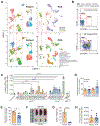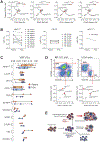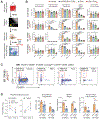A Humanized Animal Model Predicts Clonal Evolution and Therapeutic Vulnerabilities in Myeloproliferative Neoplasms
- PMID: 34193440
- PMCID: PMC8716669
- DOI: 10.1158/2159-8290.CD-20-1652
A Humanized Animal Model Predicts Clonal Evolution and Therapeutic Vulnerabilities in Myeloproliferative Neoplasms
Abstract
Myeloproliferative neoplasms (MPN) are chronic blood diseases with significant morbidity and mortality. Although sequencing studies have elucidated the genetic mutations that drive these diseases, MPNs remain largely incurable with a significant proportion of patients progressing to rapidly fatal secondary acute myeloid leukemia (sAML). Therapeutic discovery has been hampered by the inability of genetically engineered mouse models to generate key human pathologies such as bone marrow fibrosis. To circumvent these limitations, here we present a humanized animal model of myelofibrosis (MF) patient-derived xenografts (PDX). These PDXs robustly engrafted patient cells that recapitulated the patient's genetic hierarchy and pathologies such as reticulin fibrosis and propagation of MPN-initiating stem cells. The model can select for engraftment of rare leukemic subclones to identify patients with MF at risk for sAML transformation and can be used as a platform for genetic target validation and therapeutic discovery. We present a novel but generalizable model to study human MPN biology.
Significance: Although the genetic events driving MPNs are well defined, therapeutic discovery has been hampered by the inability of murine models to replicate key patient pathologies. Here, we present a PDX system to model human myelofibrosis that reproduces human pathologies and is amenable to genetic and pharmacologic manipulation. This article is highlighted in the In This Issue feature, p. 2945.
©2021 American Association for Cancer Research.
Figures






References
-
- Campbell PJ, Green AR. The Myeloproliferative Disorders. New England Journal of Medicine 2006;355(23):2452–66. - PubMed
-
- Levine RL, Wadleigh M, Cools J, Ebert BL, Wernig G, Huntly BJ, et al. Activating mutation in the tyrosine kinase JAK2 in polycythemia vera, essential thrombocythemia, and myeloid metaplasia with myelofibrosis. Cancer Cell 2005;7(4):387–97. - PubMed
-
- James C, Ugo V, Le Couedic JP, Staerk J, Delhommeau F, Lacout C, et al. A unique clonal JAK2 mutation leading to constitutive signalling causes polycythaemia vera. Nature 2005;434(7037):1144–8. - PubMed
-
- Kralovics R, Passamonti F, Buser AS, Teo SS, Tiedt R, Passweg JR, et al. A gain-of-function mutation of JAK2 in myeloproliferative disorders. N Engl J Med 2005;352(17):1779–90. - PubMed
Publication types
MeSH terms
Grants and funding
LinkOut - more resources
Full Text Sources
Molecular Biology Databases

